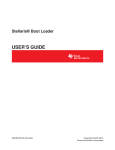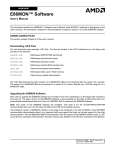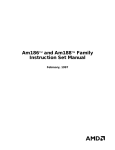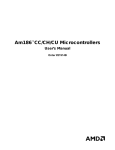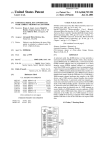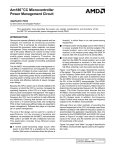Download Using the SmartDMA Controller with USB on the
Transcript
Using the SmartDMA™ Controller with
USB on the Am186™CC Microcontroller
Application Note
by Mark Langsdorf
This application note explains how using the SmartDMA™ controller with USB enhances the
functionality of an Am186™CC microcontroller. This application note assumes that the reader is
knowledgeable about the Am186CC microcontroller and USB.
INTRODUCTION
The SmartDMA controller provides a powerful and efficient way to transfer data between memory and the
USB data FIFOs on the Am186CC microcontroller.
Correctly implemented, the SmartDMA controller enables full utilization of the 12-Mbit/s full-speed bus
bandwidth of the 1.0, 1.1, and 2.0 USB specifications.
The most efficient implementation of the SmartDMA
controller is the buffer-per-IRP (I/O request packet),
which requires complex software handling, either at the
end of each buffer or for error recovery.
This application note discusses the differences between buffer-per-packet and buffer-per-IRP SmartDMA
channels, and explains why a system can use either
one. Also included are an example of how to set up a
buffer-per-IRP BULK interface and an example of error
recovery routines for the buffer-per-IRP BULK interface. The procedures and code in this application note
must be combined with EPD CodeKits CK0005xx or
CK0012xx to implement a fully functioning USB system
using the SmartDMA controller. To access the CodeKits, refer to the following link on the AMD web site:
www.amd.com/products/lpd/codekits/downloads.html.
For more information about the SmartDMA controller
and USB, refer to the Am186™CC/CH/CU Microcontrollers User ’s Manual , order #21914 and the
Am186™CC/CH/CU Microcontrollers Register Set
Manual, order #21916.
SmartDMA™ CONTROLLER MODES
When used with a USB, the SmartDMA controller on
the Am186CC microcontroller can operate in two
modes, buffer-per-packet (also known as store status)
and buffer-per-IRP (also known as no-store status).
These two modes describe the memory buffer that is
pointed to by the descriptor in the SmartDMA channel
descriptor ring.
Buffer-Per-Packet
scriptor is returned to software control by the hardware,
and the SmartDMA channel pair Current Buffer Descriptor (SDxCBD) register is automatically updated to
point to the next available buffer. If an error occurs, a
NAK is issued to terminate the transaction, and software must intervene (in some cases) to reset the
SmartDMA channel. Buffer lengths are limited to the
size of USB packets.
Buffer-Per-IRP
In buffer-per-IRP mode, several USB data packets can
share the same descriptor. The advantage of bufferper-IRP is that there is no limit to the size of each buffer.
So, several hundred bytes or more can be transferred
between each interrupt. With buffer sizes of approximately one kilobyte, the Am186CC microcontroller can
send data at the full bus rate of 12 Mbit/s.
The buffer-per-IRP method of data transfer is faster
and more efficient than buffer-per-packet because
buffer-per-IRP minimizes the overhead. Both methods
generate an interrupt after each buffer, and the
interrupts for each method take the same amount of
time to complete. The SmartDMA controller cannot
transfer data while the processor is handling an
interrupt, so data transfer is faster if fewer interrupts
occur. Because the buffer-per-IRP method generates
only one interrupt per IRP and an IRP can contain
several packets, only one interrupt occurs per several
packets, which is considerably less than with the bufferper-packet method that generates one interrupt per
packet. Therefore, the buffer-per-IRP method of data
transfer is faster and more efficient.
SETTING UP THE USB AND SmartDMA™
CONTROLLER
The following steps describe how to set up the USB
endpoints and the Smar tDMA controller on the
Am186CC microcontroller.
In buffer-per-packet mode, each USB packet has its
own descriptor. When a packet is transferred, the de-
© Copyright 1999 Advanced Micro Devices, Inc. All rights reserved.
Publication# 23112
Rev: A Amendment/0
Issue Date: November 1999
Setting Up the USB Endpoint
1. Only the USB data endpoints can be used with the
SmartDMA controller. Endpoint A must be configured for OUT data on SmartDMA Channel 2 (receive), while Endpoint B must be configured for IN
data on the SmartDMA Channel 2 (transmit). Endpoint C must be configured for OUT on Channel 3
(receive), and Endpoint D must be IN on Channel 3
(transmit). Depending on the application, the appropriate endpoint should be chosen.
2. The endpoint should be disabled and then defined.
a. Definition register 1 (xEPDEF1) controls the
endpoint number, the USB configuration, interface, setting (as set by the host during configuration), direction (IN or OUT), and the type,
which can be bulk, interrupt, or isochronous.
b. Definition register 2 (xEPDEF2) controls the
FIFO size and the maximum packet size. The
FIFO size is only relevant for IN buffers. Unless
the NOT_ZERO or NOT_LAST_BYTE bits of the
endpoint control register are cleared, the USB
controller responds to host requests with NAK
responses if the FIFO is not completely full.
c. Definition register 3 (xEPDEF3) controls the
SmartDMA channel mode and operation. For a
buffer-per-IRP transfer, set the transfer mode to
100b, clear all of the IMSK bits, and set the
BUFF_ERR_SMSK and OTH_ERR_SMSK bits.
These actions cause the endpoint to stop on any
error, generating an interrupt in the process. If
the endpoint operates in the OUT direction, the
SHRT_PKT_SMSK bit should also be set. This
action causes the endpoint to stop at the end of
the IRP, generating an interrupt. For buffer-perpacket transfer, set the mode to 101b and set the
IMSK bits. These actions cause the endpoint to
interrupt when an error occurs or a complete
packet is received or sent.
3. Set interrupt vector 0xC to point to the USB interrupt
handler.
4. Set interrupt channel 2 for an internal, leveltriggered source, and then enable it with the
CH2CON register.
Setting Up the SmartDMA™ Channel
1. Create and initialize a buffer of descriptors in
memory.
a. Allocate an array of data buffer descriptors and
a data buffer in memory.
b. Configure the buffer descriptors by setting the
LADR and HADR bytes to point to the data
buffer, and then set the OWN bit for any buffers
that are available for transfer.
2
c. Set the STP and ENP bits at the start and end
(respectively) of any buffer chains. If each
SmartDMA buffer contains all the data for a
transfer, set both the STP and ENP bits in each
buffer.
2. Program the SmartDMA control register (SDxCON).
a. Clear the start bit (xXST), and set the DSEL bit.
This stops the channel and makes USB the requesting source.
b. Clear the xXSO bit so that the hardware always
returns the descriptor to software control when
the hardware transfers BCNT bytes.
c. For IN/transmit endpoints (B or D), set the TTCI
bit to cause an interrupt after all the data is transferred.
d. For OUT/receive endpoints (A or C), do not set
any other bits.
3. Write the descriptor ring address into the appropriate Ring Address High (SDxxRAH) and Ring Address Low (SDxxRCAL) registers.
4. Set the Current Buffer Descriptor (SDxCBD) register to point to the first available buffer.
5. Turn on the SmartDMA channel.
6. For receive endpoints, turn on the USB ACT_REQ
interrupt mask.
7. For transmit endpoints, do not turn on the USB interrupt mask or the SmartDMA channel interrupt
mask until data is available.
Turning on the USB interrupt mask or the SmartDMA channel interrupt mask before data is available can cause unnecessary buffer error interrupts
to occur when the FIFO underruns.
ERROR HANDLING
Error Handling in Buffer-Per-Packet Mode
In buffer-per-packet mode, error handling is relatively
easy for IN endpoints and OTHER_ERRs on OUT endpoints. Each packet is in a separate buffer. If an error
occurs, the bad buffer returns to software control. Software clears the error bits in the buffer descriptor, resets
the addresses to point to the start of the data buffer,
and retransfers the data. Handling a USB BUF_ERR
on an OUT endpoint is complicated. The process is
similar to the process required for BUF_ERRs on
Buffer-per-IRP mode as described below.
Error Handling in Buffer-Per-IRP Mode
Error handling is more complex in buffer-per-IRP
mode. There are four separate error/direction combinations, and each condition is discussed below.
Using the SmartDMA™ Controller with USB on the Am186™CC Microcontroller Application Note
Handling USB BUF_ERR on an IN Endpoint With a
SmartDMA Channel
4. Adjust the Byte Count word to adjust for the shortened buffer length.
The BUF_ERR bit is set in the USB endpoint control
register (xEPCTL) when a buffer underun occurs—the
endpoint requests data, but the SmartDMA controller
either cannot distribute the data quickly enough, or has
no available data. This error always occurs when an IN
endpoint is activated with SmartDMA channel and
there is no data (even if the SmartDMA channel is not
turned on). The interrupt should be masked until data
is available. Assuming data is available when this error
occurs, perform the following steps:
5. Turn the SmartDMA channel back on. The host will
send a new IN token, and the packet is resent.
1. Read the SmartDMA channel current transfer address and compare it to the data buffer address.
The difference is the amount of data already transmitted.
2. Find the offset from the data buffer base address to
the start of the bad packet by removing the loworder bits (those that are smaller than the packet
size) from the amount of data transferred.
3. Add the packet-start offset to the buffer base-address and store the sum in the Address word of the
buffer descriptor. The buffer descriptor now points
to the start of the packet that needs to be resent.
4. Adjust the byte count word to adjust for the shortened buffer length.
Handling USB BUF_ERR on an OUT Endpoint with
a SmartDMA Channel
The BUF_ERR bit in the xEPCTL register is set when
the SmartDMA channel is unable to move data from the
USB FIFO fast enough. The result is the FIFO contains
part of the packet, which the host has acknowledged
and cannot resend, and contains part of an overrun
packet, which the host can resend. The error handler
must retrieve the rest of the acknowledged packet and
update the SmartDMA pointers so that the host can resend the bad packet.
1. Read the SmartDMA current receive address and
compare it to the data buffer address. The difference is the amount of data already received.
2. If more than a packet-size of data is received, perform a modulo on the received amount with the
packet size. This value is the amount of the acknowledged packet that is written to memory. In a
loop, the rest of the data must be read from the USB
FIFO and written into memory.
5. Turn the SmartDMA channel back on. The host
sends a new IN token, and the packet is re-sent.
3. Update the SmartDMA channel descriptor to point
to the start of the packet that was in transmit when
the error occurred. If data was read from the FIFO
in step 2, then the pointer does this already.
Handling USB OTHER_ERR on an IN Endpoint with
a SmartDMA Channel
4. Turn the SmartDMA channel back on. The host resends the interrupted packet.
The OTHER_ERR bit in the xEPCTL register is set
when the host responds with a NAK to the most recently transmitted packet. The SmartDMA channel
transmit pointer must be backed up to the start of the
NAK-response packet. Because part of a new packet
might be moved into the FIFO, this might involve backing up more than one packet size. The following is the
recovery process:
Handling USB OTHER_ERR on an OUT Endpoint
with a SmartDMA Channel
1. Read the SmartDMA channel current transfer address and compare it to the data buffer address.
The difference is the amount of data already transmitted.
1. Read the SmartDMA channel current receive address and compare it to the data buffer address.
The difference is the amount of data already received.
2. Reduce the amount of data transferred by one
packet size, and then perform an AND operation to
the amount transferred with the packet size. The result is the offset from the start of the data buffer to
the start of the NAK-response packet.
2. Reduce the amount of data received by a packet
size. This is the offset of the start of the bad packet.
3. Add the packet-start offset to the buffer base-address and store the sum in the Address word of the
buffer descriptor. The buffer descriptor now points
to the start of the packet that needs to be resent.
The OTHER_ERR bit is set when the device receives a
bad packet. The device immediately issues a NAK to
the packet and the host automatically resends it. The
error handler needs to rewind the SmartDMA channel
so that the re-sent packet overwrites the bad packet
data. This is done as follows:
3. Add the offset to the start of the SmartDMA channel
data buffer and assign the sum to the Address word
of the ring descriptor.
4. Adjust the Byte Count field to account for the shortened buffer.
5. Restart the SmartDMA channel and wait for the
host to resend.
Using the SmartDMA™ Controller with USB on the Am186™CC Microcontroller Application Note
3
EXAMPLE CODE
Refer to Appendix A for an example of code that shows
error recovery procedures for USB with the SmartDMA
controller. The code is not a fully functioning USB driver
and requires a HandleOtherInt() function to process
transactions (e.g., initialization, configuration) over the
control endpoint.
4
Using the SmartDMA™ Controller with USB on the Am186™CC Microcontroller Application Note
Appendix A
Example Code
The example code is a simple loopback on endpoints C and D. Data can also be sent to the device on endpoint A,
but the data is discarded. This code provides an example of error-handling procedures for USB with the SmartDMA
controller. The code is not a fully functional USB driver. This code must be combined with EPD CodeKits CK0005xx
or CK0012xx to implement a fully functioning USB system using the SmartDMA controller. To access the CodeKits,
refer to the following link on the AMD web site: www.amd.com/products/lpd/codekits/downloads.html.
#include "Am186CC.h"
#include "usb.h"
WORD GetDiff(WORD num1, WORD num2);
WORD GetLinearAddress(void far *fptr, DWORD *address);
WORD FindBuffer(SDMADescriptorFormat *ring_buffer, WORD active, WORD cbd);
void ConfigureUSB();
void ConfigureSDMA();
void UsbHandleInt();
void UsbProcessInt();
void HandleErrorD();
void HandleErrorA();
void HandleReceivedPacketA();
void HandleErrorC();
void HandleReceivedPacketC();
void HandleOtherInterrupt();
void SDMAHandleInt();
void SDMAProcessInt();
typedef struct SmartDMABufferDescriptorFormat
{
WORD
Low_address;
// Low order bits of address field
WORD
Config;
// Status and configuration
WORD
Size;
// Receive buffer size in bytes
WORD
Message_count; // Frame length in bytes
} SDMADescriptorFormat;
#define
#define
#define
#define
DESCRIPTORS
PACKET_SIZE
A_BUF_SIZE
C_BUF_SIZE
16
64
PACKET_SIZE
512
/*
/*
/*
/*
Number of descriptors in ring buffer */
Size of a USB packet */
Size of endpoint A’s buffers */
Size of endpoint C’s buffers */
char data_buf_a[DESCRIPTORS][A_BUF_SIZE]; /* Data buffers for endpoint A */
volatile SDMADescriptorFormat far ring_buffer_a[DESCRIPTORS]; /* These are
** the rings of format descriptors. Each descriptor contains the
** status for a buffer. Must be volatile since the hardware has
** access to it. */
char data_buf_c[DESCRIPTORS][C_BUF_SIZE]; /* Data buffers for endpoint C */
volatile SDMADescriptorFormat far ring_buffer_c[DESCRIPTORS]; /* These are
** the rings of format descriptors. Each descriptor contains the
** status for a buffer. Must be volatile since the hardware has
Using the SmartDMA™ Controller with USB on the Am186™CC Microcontroller Application Note A-1
** access to it. */
/* endpoint D has no data buffers - it will use either data_buf_c or
** data_buf_a. */
volatile SDMADescriptorFormat far ring_buffer_d[DESCRIPTORS]; /* These are
** the rings of format descriptors. Each descriptor contains the
** status for a buffer. Must be volatile since the hardware has
** access to it. */
WORD a_current; /* Number of the buffer currently being used by this */
WORD c_current; /* SmartDMA channel, or the number of the most recently */
WORD d_current; /* Used channel. */
void main(void)
{
ConfigureUSB();
ConfigureSDMA();
/* Loop forever */
for (;;)
;
}
/****************************************************************************
NAME
GetDiff - Return the absolute difference between two numbers
DESCRIPTION
Configures endpoint
****************************************************************************/
WORD GetDiff(WORD num1, WORD num2)
{
if (num1 > num2)
return(num1 - num2);
else
return(num2 - num1);
}
/****************************************************************************
NAME
GetLinearAddress - Get the linear address of a pointer
DESCRIPTION
****************************************************************************/
WORD GetLinearAddress(void far *fptr, DWORD *address)
{
DWORD seg, offset;
seg = (unsigned) ((DWORD)(fptr) >> 16);
offset = (unsigned) ((DWORD)(fptr) & 0xffff);
seg <<= 4;
*address = seg + offset;
return 0;
}
/****************************************************************************
NAME
FindBuffer - Search for an unused or used buffer
DESCRIPTION
****************************************************************************/
WORD FindBuffer(SDMADescriptorFormat *ring_buffer, WORD active, WORD cbd)
{
WORD found, i;
A-2 Using the SmartDMA™ Controller with USB on the Am186™CC Microcontroller Application Note
found = 0;
for (i = cbd; (i < DESCRIPTORS) &&
{
if ((ring_buffer[i].Config &
found = i + 1;
}
for (i = 0; (i < cbd) && (!found);
{
if ((ring_buffer[i].Config &
found = i + 1;
}
return found;
(!found); i++)
SDBUF_OWN) == active)
i++)
SDBUF_OWN)== active)
}
/****************************************************************************
NAME
ConfigureUSB - Configures USB endpoint A, C, and D
DESCRIPTION
Configures each endpoint’s definition registers
****************************************************************************/
void ConfigureUSB()
{
/* Turn off USB interrupts. */
outpw(UIMASK1, 0);
outpw(UIMASK2, 0);
/* Set endpoint A as a BULK/OUT endpoint with "buffer per packet
** IRP" SmartDMA. */
/* Definition register 1: Set the endpoint number to B, the configuration,
** interface, and alternate setting to 0, the direction to IN, and
** the type to BULK. */
outpw(UAEPDEF1, UEPDEF1_EP_NUM_A | UEPDEF1_EP_CFG_0 |
UEPDEF1_EP_INT_0 | UEPDEF1_EP_ASET_0 |
UEPDEF1_EP_DIR_OUT | UEPDEF1_EP_TYPE_BULK);
/* Definition register 2: 64 byte FIFO (packet size), and 64 byte
** packets */
outpw(UAEPDEF2, UEPDEF2_FIFO_SIZE_16 | UEPDEF2_EP_MX_PCT_64);
/* Definition register 3: SmartDMA with packet status,
** and an interrupt is generated on FULL_PKT or SHRT_PKT and a
** stop interrupt on BUFF_ERR or OTHER_ERR. The bits are shifted 8 to
** the left to move them from the "stop" positions to the "status" positions. */
outpw(UAEDEF3, UEPDEF3_MODE_SDMA_STAT | ((UEPCTL_FULL_PKT |
UEPCTL_SHOR_PKT) << 8) | UEPCTL_BUF_ERR |
UEPCTL_OTHER_ERR);
/* Set endpoint C as a BULK/OUT endpoint with "buffer per IRP" SmartDMA. */
/* Definition register 1: Set the endpoint number to C, the configuration,
** interface, and alternate setting to 0, the direction to OUT, and the type to
** BULK. */
outpw(UCEPDEF1, UEPDEF1_EP_NUM_C | UEPDEF1_EP_CFG_0 |
UEPDEF1_EP_INT_0 | UEPDEF1_EP_ASET_0 |
UEPDEF1_EP_DIR_OUT | UEPDEF1_EP_TYPE_BULK);
/* Definition register 2: 64-byte FIFO (packet size), and 64 byte packets */
outpw(UCEPDEF2, UEPDEF2_FIFO_SIZE_64 |UEPDEF2_EP_MX_PCT_64);
/* Definition register 3: No packet status in the OUT direction,
** and a stop interrupt is generated on SHRT_PKT, BUFF_ERR, or OTHER_ERR. */
outpw(UCEDEF3, UEPDEF3_MODE_SDMA | UEPCTL_FULL_PKT |
UEPCTL_BUF_ERR | UEPCTL_OTHER_ERR);
Using the SmartDMA™ Controller with USB on the Am186™CC Microcontroller Application Note A-3
/* Set endpoint D as a BULK/IN endpoint with "buffer per IRP" SmartDMA. */
/* Definition register 1: Set the endpoint number to C, the configuration,
** interface, and alternate setting to 0, the direction to IN, and the type to
** BULK. */
outpw(UDEPDEF1, UEPDEF1_EP_NUM_D | UEPDEF1_EP_CFG_0 |
UEPDEF1_EP_INT_0 | UEPDEF1_EP_ASET_0 |
UEPDEF1_EP_DIR_IN | UEPDEF1_EP_TYPE_BULK);
/* Definition register 2: 32-byte FIFO (packet size), and 64-byte packets */
outpw(UDEPDEF2, UEPDEF2_FIFO_SIZE_32 | UEPDEF2_EP_MX_PCT_64);
/* Definition register 3: No packet status in the OUT direction,
** and a stop interrupt is generated on SHRT_PKT, BUFF_ERR, or OTHER_ERR. */
outpw(UDEDEF3, UEPDEF3_MODE_SDMA | UEPCTL_BUF_ERR |
UEPCTL_OTHER_ERR);
/* Set up the USB interrupt channel and vector. */
{
unsigned long far *VectorTable;
/* Address of handler offset value */
VectorTable = (unsigned long far *) (ITYPE_USB << 2);
*VectorTable = (unsigned long) USBHandleInt;
}
outpw(CH2CON, CHCON_SRC_INTERNAL | CHCON_LTM | CHCON_PR6);
/* Turn on the receive interrupts. */
outpw(UIMASK1, UIMASK1_C_EP_ACT | UIMASK1_A_EP_STATINT |
UIMASK1_A_EP_ACT | UIMASK1_OTHER_INT
UIMASK1_CNT_EP_NEW |UIMASK1_CNT_EP_ACT);
}
/****************************************************************************
NAME
ConfigureSDMA - Configures SmartDMA channels 2 and 3
DESCRIPTION
Configures the SmartDMA channels to work with endpoints A, C, and D
****************************************************************************/
void ConfigureSDMA()
{
DWORD address;
WORD i;
/* Set up SDMA Channel 2. */
/* SDMA Control register: Receive Set Own, medium priority, USB
** as requesting source. */
outpw(SD2CON, SDCON_RXSO | SDCON_P_MED | SDCON_DEL_USB);
GetLinearAddress(ring_buffer_a, &address);
outpw(SD2RRCAL, ((WORD) address & 0xfff0)| SDRRCAL_RRC_16);
outpw(SD2RRAH, (WORD) ((address >> 16) & 0x000f));
for (i = 0; i < DESCRIPTORS; i++)
{
GetLinearAddress(data_buf_a[i], &address);
ring_buffer_a[i].Low_address = (WORD) address & 0xffff;
ring_buffer_a[i].Low_address = SDBUF_OWN | 0x0300 |
((WORD) (address >> 16) & 0x000f);
ring_buffer_a[i].Size = (~A_BUF_SIZE + 1) & 0x7FFF;
ring_buffer_a[i].Message_count = 0;
}
a_current = 0;
A-4 Using the SmartDMA™ Controller with USB on the Am186™CC Microcontroller Application Note
/* Set up SDMA Channel 3. */
/* SDMA Control register: Transmit terminal count interrupt,
** medium priority, USB as requesting source. */
outpw(SD3CON, SDCON_TTCI | SDCON_TXSO | SDCON_RXSO | SDCON_P_MED |
SDCON_DEL_USB);
GetLinearAddress(ring_buffer_c, &address);
outpw(SD3RRCAL, ((WORD) address & 0xfff0)| SDRRCAL_RRC_16);
outpw(SD3RRAH, (WORD) ((address >> 16) & 0x000f));
/* Set up the receive ring descriptor to point to the available
** data buffers. */
for (i = 0; i < DESCRIPTORS; i++)
{
GetLinearAddress(data_buf_c[i], &address);
ring_buffer_c[i].Low_address = (WORD) address & 0xffff;
ring_buffer_c[i].Low_address = SDBUF_OWN | 0x0300 |
((WORD) (address >> 16) & 0x000f);
ring_buffer_c[i].Size = (~C_BUF_SIZE + 1) & 0x7FFF;
ring_buffer_c[i].Message_count = 0;
}
c_current = 0;
GetLinearAddress(ring_buffer_d, &address);
outpw(SD3TRCAL, ((WORD) address & 0xfff0)| SDTRCAL_TRC_16);
outpw(SD3TRAH, (WORD) ((address >> 16) & 0x000f));
/* Set up the transmit ring descriptors to not point anywhere. Leave
** them under software control so we can adjust them after we receive
** data. */
for (i = 0; i < DESCRIPTORS; i++)
{
ring_buffer_d[i].Low_address = 0;
ring_buffer_d[i].Low_address = 0x0300;
ring_buffer_c[i].Size = 0;
ring_buffer_c[i].Message_count = 0;
}
/* Set up the SDMA interrupt channels and vectors. */
{
unsigned long far *VectorTable;
/* Address of handler offset value */
VectorTable = (unsigned long far *) (ITYPE_SDMA3 << 2);
*VectorTable = (unsigned long) SDMAHandleInt;
}
outpw(CH7CON, CHCON_PR6);
}
/****************************************************************************
NAME
UsbHandleInt - USB Interrupt handler
DESCRIPTION
Calls the USB interrupt processor and cleans up the end-of-interrupt
register afterwards
****************************************************************************/
void interrupt UsbHandleInt()
{
UsbProcessInt();
Using the SmartDMA™ Controller with USB on the Am186™CC Microcontroller Application Note A-5
outpw(EOI, EOITYPE_USB);
}
/****************************************************************************
NAME
UsbProcessInt - Determine interrupt cause and finish interrupt
DESCRIPTION
This function loops, checking to see what condition caused the USB
interrupt, until all sources are handled. Depending on the interrupt
source, it will usually shut down a SDMA channel and mask out an
endpoint interrupt while it uses a subfunction to handle the source.
****************************************************************************/
void UsbProcessInt()
{
/* First determine which endpoint is causing the interrupt. */
volatile WORD status;
while ((status = inpw(UISTAT1)) != 0)
{
/* Check for transmit errors first. */
if (status & UISTAT1_D_EP_ACT)
{
WORD uimask, sdcon;
/* Stop the DMA while we figure out the interrupt source. */
uimask = inpw(UIMASK1);
sdcon = inpw(SD3CON);
outpw(UIMASK1, uimask & ~UISTAT1_D_EP_ACT);
outpw(SD3CON, sdcon & ~SDCON_TXST);
/* Since this is a transmit line, we’ve programmed SmartDMA to
** interrupt after completely sending a packet. The USB only
** interrupts if there’s been an error. */
HandleErrorD();
/* Now that we’ve handled the interrupt, clear the
** act_req bit, turn interrupts back on, and resume. */
outpw(UDEPCTL, inpw(UDEPCTL) &~ UEPCTL_ACT_REQ);
outpw(UIMASK1, uimask);
outpw(SD3CON, sdcon);
}
/* Then check for actions on the A endpoint. */
else if (status & UISTAT_A_EP_ACT)
{
WORD a_status, uimask, sdcon;
/* Stop the DMA while we figure out the interrupt source. */
uimask = inpw(UIMASK1);
sdcon = inpw(SD2CON);
outpw(UIMASK1, uimask & ~UISTAT1_A_EP_ACT);
outpw(SD2CON, sdcon & ~SDCON_RXST);
a_status = inpw(UAEPCTL);
if ((a_status & UEPCTL_BUF_ERR)||(a_status (UEPCTL_OTHER_ERR)
HandleErrA();
/* Now that we’ve handled the interrupt, clear the
** act_req bit, turn interrupts back on, and resume. */
outpw(UAEPCTL, inpw(UAEPCTL) &~ UEPCTL_ACT_REQ);
outpw(UIMASK1, uimask);
outpw(SD2CON, sdcon);
}
else if (status & UISTAT_A_STATINT)
{
A-6 Using the SmartDMA™ Controller with USB on the Am186™CC Microcontroller Application Note
/* The SmartDMA places each new packet in its own buffer, so
** there’s no need to stop on that. We can keep receiving
** data while we handle each packet. */
HandleReceivedPacketA();
}
else if (status & UISTAT_C_EP_ACT)
{
WORD c_status, uimask, sdcon;
/* Stop the DMA while we figure out the interrupt source. */
uimask = inpw(UIMASK1);
sdcon = inpw(SD3CON);
outpw(UIMASK1, uimask & ~UISTAT1_C_EP_ACT);
outpw(SD3CON, sdcon & ~SDCON_RXST);
c_status = inpw(UCEPCTL);
/* There can either be an error condition, or a short packet
** condition on this endpoint. Short packet means the host is
** done sending the IRP and we need to handle the packet. */
if ((c_status & UEPCTL_BUF_ERR)|| (c_status & (UEPCTL_OTHER_ERR))
HandleErrC();
else if (c_status & (UEPCTL_SHOR_PKT) HandleReceivedPacketC();
/* Now that we’ve handled the interrupt, clear the
** act_req bit, turn interrupts back on, and resume. */
outpw(UCEPCTL, inpw(UCEPCTL) &~ UEPCTL_ACT_REQ);
outpw(UIMASK1, uimask);
outpw(SD3CON, sdcon);
}
else
/* Must be a control endpoint or general USB status interrupt. */
HandleOtherInterrupt();
}
}
/****************************************************************************
NAME
HandleErrorD - Handle an error on the D endpoint
DESCRIPTION
This function handles an error on the D endpoint. If there is a
BUFFER (underrun) error, it retransmits the current packet.
If there is an OTHER (NAK) error, it retransmits the previous packet.
****************************************************************************/
void HandleErrorD()
{
WORD current_address, current_ring, length;
WORD error_cause = inpw(UDEPCTL);
current_ring = inpw(SD3CBD) & 0x00ff;
current_address = inpw(SD3TCAD);
length = GetDiff(current_address, ring_buffer_d[current_ring].Low_address);
/* First, determine the source of the error. */
if (error_cause & UEPCTL_BUF_ERR)
{
/* BUFF_ERR indicates an error in the current packet. We need to
** point the SDMA to the start of the current packet and resend it. */
/* Each packet is PACKET_SIZE bytes, so chopping off the lower bits will
** give us the offset of the packet start. Add that to the
** beginning of the buffer. */
ring_buffer_d[current_ring].Low_address+= length & ~(PACKET_SIZE - 1);
/* The buffer length has decreased by the amount of data
Using the SmartDMA™ Controller with USB on the Am186™CC Microcontroller Application Note A-7
** already transmitted. */
ring_buffer_d[current_ring].Size -= length & (PACKET_SIZE - 1);
/* Flush the FIFO and clear the error bit. */
outpw(UDEPCTL, inpw(UAEPCTL) & ~(UEPCTL_NOT_FLUSH | UEPCTL_BUF_ERR));
}
else if (error_cause & UEPCTL_OTHER_ERR)
{
/* OTHER_ERR indicates the previous packet was NAK’ed, so we need to
** point the SDMA to the previous packet and resend it. */
if (length < PACKET_SIZE)
/* No previous packet. We shouldn’t get this, but set the
** length to PACKET_SIZE just to be safe. */
length = PACKET_SIZE;
length -= PACKET_SIZE; /* Back up a packet length. */
/* Each packet is PACKET_SIZE bytes, so chopping off the lower bits will
** give us the offset of the packet start. Add that to the
** beginning of the buffer. */
ring_buffer_d[current_ring].Low_address+= length & PACKET_SIZE;
/* The buffer length has to be decreased by the amount of data
** already transmitted. */
ring_buffer_d[current_ring].Size -= length & PACKET_SIZE;
/* Flush the FIFO and clear the error bit. */
outpw(UDEPCTL, inpw(UAEPCTL) & ~(UEPCTL_NOT_FLUSH | UEPCTL_OTHER_ERR));
}
else
{
printf("unknown interrupt source");
}
}
/****************************************************************************
NAME
HandleErrorA - Handle an error on the A endpoint
DESCRIPTION
This function recovers the data for any buffer with partially
written data in it, and discards any buffer with bad data in it.
****************************************************************************/
void HandleErrorA()
{
ring_buffer_a[a_current].Config &= ~SDBUF_OWN;
DWORD address;
WORD low_address, status;
GetLinearAddress(data_buf_a[a_current], &address);
low_addres = (WORD) address & 0xffff;
status = inpw(UAEPCTL);
if (status & UEPCTL_OTHER_ERR)
{
/* The packet was rejected. Discard it and wait for the host
** to retransmit. */
ring_buffer_a[a_current].Size = (~A_BUF_SIZE + 1) & 0x7FFF;
ring_buffer_a[a_current].Low_address = low_address;
ring_buffer_a[a_current].Message_count = 0;
ring_buffer_a[a_current].Config = (WORD) ((address >> 16) &
0x000f)) | SDBUF_OWN | 0x0200;
}
else
{
A-8 Using the SmartDMA™ Controller with USB on the Am186™CC Microcontroller Application Note
WORD length, packet_size, i;
char * data_buf = data_buf_a[a_current];
/* Was the previous packet full-length, or short? We know that
** full-length packets have a total of packet-size bytes in
** them, and we can read the PACKET_SIZE register to get the
** size of shorter packets. */
if (status & UEPCTL_SHOR_PKT)
packet_size = inpw(UAEPSIZ);
else
packet_size = PACKET_SIZE;
length = GetDiff(inpw(SD2CRAD), ring_buffer_a[a_current].Low_address);
if (length > packet_size)
{
/* If the amount of data written from the FIFO is longer than
** the amount of data originally in the FIFO, we have a real
** problem. */
printf("error\n"); return;
}
/* We need to read the unread data from the FIFO. It starts
** at the length offset into the FIFO, and continues to the
** packet size. */
for (i = length; i < packet_size; i++)
{
/* Read the data from the FIFO and write it to memory. */
data_buf[length + i] = inpw(UAEPDAT);
}
/* Update the message count and clear the error bit. */
ring_buffer_a[a_current].Message_count = packet_size;
ring_buffer_a[a_current].Config = (WORD) ((address >>16) & 0x000f)) |
0x0200;
/* We have now received a packet. Invoke the packet handler
** routine. */
HandleReceivedPacketA();
}
/* Clear the error bits and flush the FIFO. */
outpw(UAEPCTL, inpw(UAEPCTL) & ~(UEPCTL_NOT_FLUSH | UEPCTL_BUF_ERR
|UEPCTL_OTHER_ERR));
}
/****************************************************************************
NAME
HandleReceivedPacketA - Handle a successful receive on the A endpoint
DESCRIPTION
This function handles packets on the A endpoint by dropping them to
the floor and resetting the most recently used buffer descriptor.
****************************************************************************/
void HandleReceivedPacketA()
{
DWORD address;
/* Get the original address of this data buffer. */
GetLinearAddress(data_buf_a[a_current], &address);
/* Reset the buffer. */
ring_buffer_a[a_current].Size = (~PACKET_SIZE + 1) & 0x7FFF;
ring_buffer_a[a_current].Low_address = (WORD) address & 0xffff;
ring_buffer_a[a_current].Config = (WORD) ((address >> 16) & 0x000f)) | SDBUF_OWN
| 0x0200;
a_current = (outpw(SD2CBD) & 0xff00) >> 8;
}
Using the SmartDMA™ Controller with USB on the Am186™CC Microcontroller Application Note A-9
/****************************************************************************
NAME
HandleErrorC - Handle an error on the C endpoint
DESCRIPTION
This function recovers from a buffer error on the C endpoint.
If a buffer overrun caused the error, the function pulls any
data from a previously ACK’ed packet from the FIFO and writes it to
memory. It then updates the SDMA descriptor to point to after the end
of the newly written packet and prepares for the host to retransmit
the NAK’ed packet. If the error was caused by the device NAK’ing a
packet, the function rewinds the SDMA descriptor to point to the start
of the NAK’ed packet. The host will retransmit normally.
****************************************************************************/
void HandleErrorC()
{
DWORD address; WORD low_address, length, bytes_left;
WORD error_cause = inpw(UDEPCTL);
GetLinearAddress(data_buf_c[c_current], &address);
low_address = inpw(SD3RCAD);
length = GetDiff(low_address, ring_buffer_c[c_current].Low_address);
/* Check to see what the error condition is. */
if (error_cause & UEPCTL_BUF_ERR)
{
/* BUFF_ERR indicates an overflow in the current packet. Part of
** the previous packet might be in the buffer, so we need to
** pull that out and store it in the data buffer. Then we need
** to point the DMA to the start of the current buffer, flush the
** buffer, and continue. */
if (length > PACKET_SIZE)
{
int bytes_left, i;
char * data_buf = data_buf_c[c_current];
/* Determine the number of bytes left from the previous packet. */
bytes_left = PACKET_SIZE - (length % PACKET_SIZE);
/* Read the bytes left from the previous packet. */
for (i = 0; i < bytes_left; i++) data_buf[length + i] =
inpw(UCEPDAT);
/* Update the length to point to past the end of the packet that
** was just read from the data FIFO. */
length = (length & PACKET_SIZE) + PACKET_SIZE;
}
/* Point the data to the start of the interrupted packet. */
ring_buffer_c[c_current].Low_address += length & PACKET_SIZE;
/* The buffer length has to be decreased by the amount of data
** already received. */
ring_buffer_c[c_current].Size -= length & PACKET_SIZE;
outpw(UCEPCTL, inpw(UCEPCTL) & ~(UEPCTL_NOT_FLUSH | UEPCTL_BUF_ERR));
}
else if (error_cause & UEPCTL_OTHER_ERR)
{
/* OTHER_ERR indicates the most recently received packet was NAK’ed,
** so we need to rewind the SDMA so that it will overwrite the
** previous packet. */
if (length >= PACKET_SIZE) length -= PACKET_SIZE;
/* Point the write pointer to the start of the NAK’d packet. */
ring_buffer_c[c_current].Low_address += length & PACKET_SIZE;
A-10 Using the SmartDMA™ Controller with USB on the Am186™CC Microcontroller Application Note
/* The buffer length has to be decreased by the amount of data
** already received. */
ring_buffer_c[c_current].Size -= length & PACKET_SIZE;
outpw(UCEPCTL, inpw(UCEPCTL) & ~(UEPCTL_NOT_FLUSH |
UEPCTL_OTHER_ERR));
}
else
{
printf("unknown interrupt source");
}
}
/****************************************************************************
NAME
HandleReceivedPacketC - Handle a successful receive on the C endpoint
DESCRIPTION
An entire buffer has been received, so we need to queue it up for
transmit on endpoint D. The first step is to find an unused buffer
descriptor in the endpoint D ring. (The handler will continue to be
called until a buffer is available.) We need to set the D descriptor
to point to the start of the "current" C data buffer. If the D channel
is not currently transmitting, it is turned on so it can transmit at the
next request of the host. Once the buffer has been transferred to D’s
control, we need to find another receive buffer.
****************************************************************************/
void HandleReceivedPacketC()
{
/* Short packets indicate the end of an IRP. Process the buffer
** by passing it to the transmit channel for loopback. */
DWORD address; WORD cbd, found;
/* First find an unused buffer descriptor on endpoint D. */
cbd = inpw(SD3CBD) & 0x00ff; found = FindBuffer(ring_buffer_d, cbd, 0);
if (found)
{
/* Point the D descriptor to the recently received buffer. */
WORD length;
GetLinearAddress(data_buf_c[c_current], &address);
ring_buffer_d[found - 1].Low_address = (WORD) address & 0xffff;
ring_buffer_d[found - 1].Config |= (WORD) ((address >> 16) & 0x000f)) |
0x0200;
/* The difference between the data buffer start and the location
** of the last SDMA write is the length of the buffer. We could
** also use the 4th word of the descriptor if we were writing
** status, which we aren’t. */
length = GetDiff(inpw(SD3CRAD), ring_buffer_d[found - 1].Low_address);
ring_buffer_d[found -1].Size = 0x8000 | (~length + 1);
ring_buffer_d[found - 1].Config |= SDBUF_OWN;
/* Check to see if the SDMA transmitter is active. If it isn’t,
** make it active and turn on the interrupts. Otherwise, let the
** SDMA transfer interrupt handle the buffer. */
if ((SD3CON0 & SDCON_TXST) == 0)
{
/* Point the CBD to the found buffer. */
outpw(SD3CBD, inpw(SD3CBD) | found - 1);
/* Turn on SmartDMA transmission. */
outpw(SD3CON, inpw(SD3CON) | SDCON_TXST);
/* Clear the USB of any errors. */
Using the SmartDMA™ Controller with USB on the Am186™CC Microcontroller Application Note A-11
outpw(UDEPCTL, inpw(UDEPCTL) & ~UEPCTL_OTHER_ERR);
/* Turn on USB interrupts. */
outpw(UIMASK1, inpw(UIMASK1) | UISTAT1_D_EP_ACT);
}
/* Find the next empty receive buffer descriptor. */
found = FindBuffer(ring_buffer_c, c_current, SDBUF_OWN);
if (found)
{
/* Return the current buffer to the available pool. */
ring_buffer_c[c_current].Size = (~C_BUF_SIZE + 1) & 0x7FFF;
ring_buffer_c[c_current].Low_address = (WORD) address & 0xffff;
ring_buffer_c[c_current].Config = (WORD) ((address >>
16) & 0x000f)) | SDBUF_OWN | 0x0200;
/* Point the SDMA to this buffer so that the next OUT token
** will write to it. */
c_current = found - 1;
outpw(SD3CBD, inpw(SD3CDB) | (c_current << 8));
/* Clear the short packet bit now that the interrupt is
** fully handled. */
outpw(UCEPCTL, inpw(UCEPCTL) & ~UEPCTL_SHOR_PKT);
}
}
}
/****************************************************************************
NAME
HandleOtherInterrupt - Handle non-DMA interrupts
DESCRIPTION
This is a placeholder function for full-featured USB interrupt handler.
****************************************************************************/
void HandleOtherInterrupt()
{
/* This function would handle Control endpoint messages
** and other standard USB interrupts. For a detailed
** example of a full-featured USB interrupt handler,
** study CodeKits CK0005xx or CK0012xx available on the EPD
** website. */
}
/****************************************************************************
NAME
SDMAHandleInt - SmartDMA interrupt
DESCRIPTION
This function should be activated when SDMA channel 3 generates a
transmit terminal count interrupt. It calls the interrupt processor
and writes to the end of the interrupt register.
****************************************************************************/
void interrupt SDMAHandleInt()
{
SDMAProcessInt();
outpw(EOI, EOITYPE_SDMA3);
}
/****************************************************************************
NAME
SDMAProcessInt - Handle a successful transmit on the D endpoint
DESCRIPTION
This function is called when an entire buffer is transmitted. It
A-12 Using the SmartDMA™ Controller with USB on the Am186™CC Microcontroller Application Note
masks the USB interrupt to avoid being repeatedly called on buffer
underrun and turns off the SDMA transmit channel. It then checks
to see if there are any other buffers that need to be transmitted.
If there are, it points the CBD at the buffer and turns the channel
and interrupts back on. The transmit buffers are prepared by the C
channel receive function, HandleReceivedPacketC().
****************************************************************************/
void SDMAProcessInt()
{
WORD found, cbd;
/* Check for interrupt source. */
if ((inpw(SD3STAT) & SDSTAT_TTC) == 0)
{
/* TTC is the only interrupt we should get. */
printf("unknown interrupt\n");
return;
}
else
/* Clear the interrupt. */
outpw(SD3STAT, 0);
/* Turn off USB interrupts and SmartDMA transmission. */
outpw(UIMASK1, inpw(UIMASK1) & ~UISTAT1_D_EP_ACT);
outpw(SD3CON, inpw(SD3CON) & ~SDCON_TXST);
/* Check for any additional buffers that need to be
** transmitted. These buffers have already been prepared by the
** receiver function. */
cbd = inpw(SD3CBD) & 0x00ff;
found = FindBuffer(ring_buffer_d, cbd, SDBUF_OWN);
if (found)
{
/* Point the CBD to the found buffer. */
outpw(SD3CBD, inpw(SD3CBD) | found - 1);
/* Turn on SmartDMA transmission. */
outpw(SD3CON, inpw(SD3CON) | SDCON_TXST);
/* Clear the USB of any errors. */
outpw(UDEPCTL, inpw(UDEPCTL) & ~UEPCTL_OTHER_ERR);
/* Turn on USB interrupts. */
outpw(UIMASK1, inpw(UIMASK1) | UISTAT1_D_EP_ACT);
}
}
Using the SmartDMA™ Controller with USB on the Am186™CC Microcontroller Application Note A-13
Trademarks
AMD, the AMD logo, and combinations thereof, Am186 and SmartDMA are trademarks of Advanced Micro Devices, Inc.
Product names used in this publication are for identification purposes only and may be trademarks of their respective companies.
Disclaimer
The contents of this document are provided in connection with Advanced Micro Devices, Inc. ("AMD") products. AMD makes no representations
or warranties with respect to the accuracy or completeness of the contents of this publication and reserves the right to make changes to specifications and product descriptions at any time without notice. No license, whether express, implied, arising by estoppel or otherwise, to any intellectual property rights is granted by this publication. Except as set forth in AMD’s Standard Terms and Conditions of Sale, AMD assumes no
liability whatsoever, and disclaims any express or implied warranty, relating to its products including, but not limited to, the implied warranty of
merchantability, fitness for a particular purpose, or infringement of any intellectual property right.
AMD’s products are not designed, intended, authorized or warranted for use as components in systems intended for surgical implant into the
body, or in other applications intended to support or sustain life, or in any other application in which the failure of AMD’s product could create a
situation where personal injury, death, or severe property or environmental damage may occur. AMD reserves the right to discontinue or make
changes to its products at any time without notice.
A-14 Using the SmartDMA™ Controller with USB on the Am186™CC Microcontroller Application Note


















